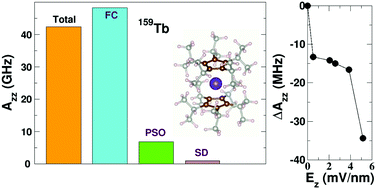Electrically tuned hyperfine spectrum in neutral Tb(ii)(CpiPr5)2 single-molecule magnet†
Abstract
Molecular spin qubits with long spin coherence time as well as non-invasive operation methods on such qubits are in high demand. It was shown that both molecular electronic and nuclear spin levels can be used as qubits. In solid state systems with dopants, an electric field was shown to effectively change the spacing between the nuclear spin qubit levels when the electron spin density is high at the nucleus of the dopant. Inspired by such solid-state systems, we propose that divalent lanthanide (Ln) complexes with an unusual electronic configuration of Ln2+ have a strong interaction between the Ln nuclear spin and the electronic degrees of freedom, which renders electrical tuning of the interaction. As an example, we study electronic structure and hyperfine interaction of the 159Tb nucleus in a neutral Tb(II)(CpiPr5)2 single-molecule magnet (SMM), which exhibits unusually long magnetization relaxation time, using the complete active space self-consistent field (CASSCF) method with spin–orbit interaction included within the restricted active space state interaction (RASSI). Our calculations show that the low-energy states arise from 4f8(6s,5dz2)1, 4f8(5dx2−y2)1, and 4f8(5dxy)1 configurations. We compute the hyperfine interaction parameters and the electronic–nuclear spectrum within our multiconfigurational approach. We find that the hyperfine interaction is about one order of magnitude greater than that for Tb(III)Pc2 SMMs. This stems from the strong Fermi contact interaction between the Tb nuclear spin and the electron spin density at the nucleus that originates from the occupation of the (6s,5d) orbitals. We also uncover that the response of the Fermi contact term to electric field results in electrical tuning of the electronic–nuclear level separations. This hyperfine Stark effect may be useful for applications of molecular nuclear spins for quantum computing.

- This article is part of the themed collection: Quantum Computing and Quantum Information Storage


 Please wait while we load your content...
Please wait while we load your content...